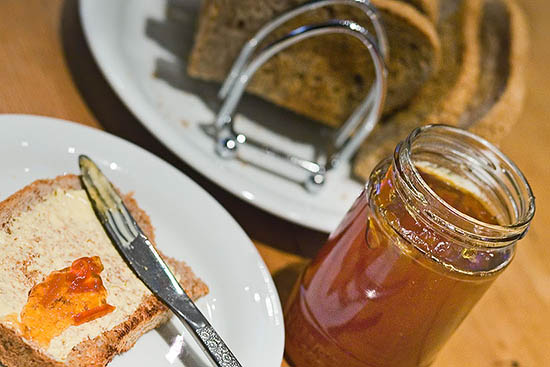We spent today making marmalade again (You can read about our first attempt last year here.) If you are wondering how we did that now that Seville oranges are no longer in season; well we put some in the freezer in January (because we hadn’t moved back into the house during the building work).
This post is just an addendum to the original one as we tried a few changes to the original recipe (which is repeated below). The main changes are that we added 2 limes and a grapefruit (skin and fruit), only used 1.7kg of sugar and that we put everything into the slow cooker the night before and left it on low over night. Which makes it a pretty simple way of making marmalade.
This resulted in a ‘sharper’ taste which we prefer, we did find that we had to boil for a longer time to get it to set. This could be down to the fact that the fruit was frozen before use and may have lost some of its pectin. Anyway here’s the original recipe (below) and you can try it with the changes if you want.

Here is our marmalade recipe. Makes 6-8 jars
1 kg Seville oranges
1.7 litres near-boiling water
Juice of 2 lemons
2 kg sugar
Wash and scrub the oranges if you are obsessive; then cut them in half, squeeze the juice and keep it somewhere for later. Remove the membrane, pith and pips etc. with a spoon (you can slightly warm the cut oranges in a microwave if you want to make this easier) and tie all this up in a piece of muslin. Slice the orange peel into strips (removing as much pith as possible), chunks, or whatever you prefer. The slices you cut at this point will determine the size of the shreds/chunks in the finished marmalade don’t feel you have to put it all in. We tend to put about two thirds of the rind in (this year I put all the rind in!).
Put the peel and the muslin bag full of pips and orange flesh in to the cooking pot of the slow cooker. Pour over the water and lemon juice. Cover and switch to high, leave for 6 hours. Alternatively we reckon that you could put it on low and leave it overnight – but we haven’t tried this yet. The peel must be really soft before adding the sugar.
Remove the muslin bag and leave it until cool. Squeeze the liquid from it into a large pan. Add the rind and cooking liquid from the slow cooker and then add the sugar. Finally pour over the orange juice you squeezed from the oranges earlier. Heat gently until the sugar has dissolved.
Put a plate in the freezer at this point to test the setting point later.
Bring to the boil and keep boiling rapidly for 15 minutes until the marmalade reaches 105°C on a sugar thermometer. If you don’t have a sugar thermometer, you can put a few drops of the liquid onto your frozen plate out of the freezer, and leave it for about a minute. Push it along a bit with a finger. If it leaves a ‘wrinkly track’ then it has reached the setting point – if not, keep boiling.
The setting point was a learning curve for us (and we don’t have a thermometer) but get it boiling gently. You don’t want a big ‘frothy’ boil – more of a point just beyond a simmer. For the first 15 minutes or so it will look a bit watery, as it gradually thickens it will become more viscous and you should have what other recipes describe as a ‘rolling boil’ (this is sort of how you imagine an Icelandic mud hole bubbling away). Keep stirring to ensure it doesn’t burn. Ours actually took about 30 minutes in total before the it left a ‘tacky track’ on the plate test.
Once the setting point has been reached, turn off the heat and skim off any scummy nastiness from the top. Leave it all to cool for about 15 minutes.
Put your clean jars into the oven, at about 120°C so that they are sterilised and warm when the hot marmalade goes in later; alternatively get them hot (and dry) out of the dishwasher when it has finished.
Stir the marmalade to distribute the peel evenly, then ladle into the heated jars. Seal with waxed paper, clean and leave to cool with a cloth over the top. When they have completely cooled, top with jam pot covers and lids and label.
Store somewhere cool and dry and use within a year.

